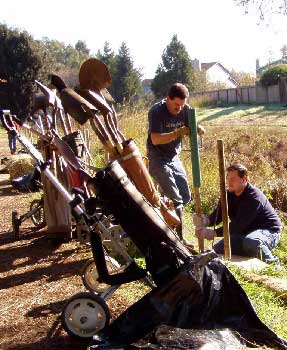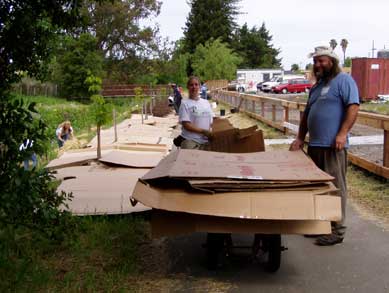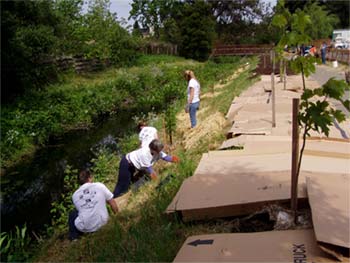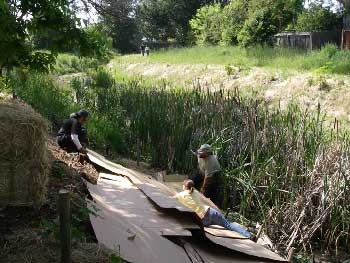|
...or REDUCE, REUSE, RECYCLE
Cotati Creek Critters is dedicated to conserving natural resources, to reusing and recycling, and to using low-impact, environmentally friendly, appropriate technology whenever possible.
Our base of operations, nick-named “Ladybug Lot” at Cotati City well lot # 2 on Lakewood Avenue, contains a used ocean shipping container for secure storage of our tools and equipment. Compost bins, plant benches and other nursery fixtures are made from salvaged redwood lumber.
 |
Tools: Many of our tools have been acquired from Recycletown, from flea markets, or as donations. Most of our shovels, forks, rakes, pruners, hand tools, etc. have been refurbished. Blades have been sharpened and oiled, and wooden handles have been sanded down, with linseed oil applied to bring old tools up to scratch.
One of the Cotati Creek Critters’ unique hallmarks is the golf caddies we use to transport shovels and other tools to specific worksites. |
Cardboard and rice straw are used as mulch for weed suppression and to retain moisture in the soil. Every tree and shrub we plant is ringed with two large overlapping pieces of cardboard. Cardboard provides a much more satisfactory weed barrier than commercial weed fabric, which tends to create unsightly garbage in the long run, while the cardboard, recycled by earthworms and other organisms, eventually decomposes, adding organic matter to the soil. A thick layer of straw is placed on top of the cardboard to further suppress weeds and retain moisture. The straw is weed-free rice straw, an agricultural waste product. It too eventually decomposes to form soil.
 
 
What’s the scoop on straw and hay? Many people confuse straw and hay but in reality they are completely different. Hay consists of dried grasses and herbs which can be fed to animals such as horses in the winter time. It contains seeds and weeds. It is not used for mulching because the weeds would flourish. Straw consists of the stalks of grains such as rice and wheat, and contains no nutritional value and few if any weeds. It is an agricultural waste product which used to be burned, but due to air pollution the burning of straw has been banned including in the Central Valleys of California. It can be ploughed into the soil but not repeatedly, as eventually it would have a negative impact on soil structure. Rice straw is high in silica which makes it moisture resistant, and if kept dry it can last for thousands of years, as evidenced by straw found in the pyramids of Egypt. Tied tightly into bales, it is used as an alternative to wood in the construction of straw bale buildings, or mixed with earth to form cob, as a more flexible building material.
Stakes: Wooden planting stakes facilitate maintenance of our plants, helping to locate and protect the plants from weedwhacking and mowing. In addition they hold the cardboard and straw in place, reducing the likelihood of it blowing away or washing into the creek. All of our tree stakes are reused landscape and orchard stakes, and many have been donated by Sonoma Mountain Village.
Bird nesting boxes: As part of our project, Wade Belew, Stewardship Coordinator, has constructed and installed 40 bird nesting boxes. The boxes are carefully designed for specific birds. They are made from recycled lumber including old redwood fence boards.
Many thanks to the following for their generous donations:
Recycletown for tools and other supplies.
Sonoma County Compost for compost, mulch, and wood.
Sonoma Mountain Village for planting stakes. |
 |
|
